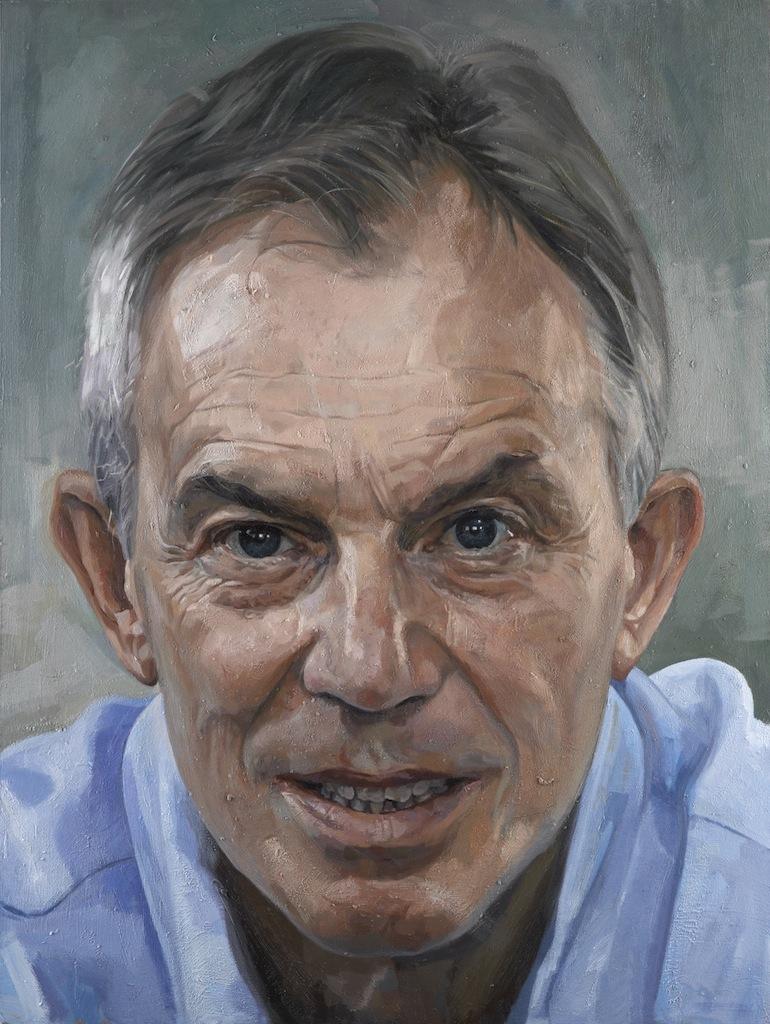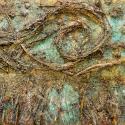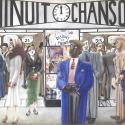“Repellent” is one word I’ve heard to describe Alastair Adams’ new portrait of Tony Blair, but I don’t know if that’s a reaction to the painting or the subject. In either case, I can’t say I share that gut-reaction. Most of the portraits in the National Portrait Gallery manage to say very little about the subject or their reputation. This one does, so that’s my first positive response to it.
In case you were wondering “why?” or “why now?”, the NPG’s commission is in line with their policy of acquiring a painted portrait of all former British prime ministers. I think they chose well in Adams, who is an artist who first trained as an illustrator and is now president of the Royal Society of Portrait Painters. I’m inclined to think that his background in illustration is important to the success of this painting, in terms of what it reveals or suggests about the sitter.
As he leans forward, fixing us with his messianic gaze, one eye threatens to go all Steve Bell on us
If we think about who the great political artists of our era are, they’re not fine artists but cartoonists and illustrators. Their art is about getting to the heart of a subject with the least possible means, the means being a few swift lines. And you can only exaggerate for comic effect when you understand the essence of what you’re trying to capture.
Contemporary painters have contributed little to the job of capturing an enduring image of our political leaders, and portrait painters in particular, those “old-fashioned” figurative artists, are often caught in a quandary that involves a struggle between creating a striking painting that feels and looks like a contemporary painting, and capturing an accurate likeness that delves deeper than its surface.
The last portrait of a former British prime minister to hang on the walls of the NPG is John Major by John Wonnacott. (I’m assuming they won’t conveniently forget Gordon Brown, though everyone else probably has.) I don’t like Wonnacott’s paintings. His work strikes me as the painterly equivalent of Buckingham Palace – too much pomp and circumstance, detail and frippery, and a good deal of unnecessary icing, under which all the proportions are wrong. It all adds up to a dog’s breakfast. And as one, after all, wishes to see the dog and not his breakfast, one finds Wonnacott’s sitters are frustratingly lost amid all the posh home furnishings.
The portrait of Tony Blair is very different. It’s four feet by three of Blair in close-up. That’s a lot of skin surface, and some may find this alarming. The skin here looks tanned and leathery, and where the impastoed paint has gnarled we find warty imperfections. As he leans forward, fixing us with his messianic gaze, one eye threatens to go all Steve Bell on us (see how it's the cartoonists who burn their caricatures into the mind). No image of Blair has ever made him look harder. But this is surely not the hardness of corruption – though there is indeed the air of the hard-bitten politician – but of conviction. Yet how closely the two appear to converge here.
I don’t think this is a great painting in terms of its striking painterly qualities, but I do find it a very interesting portrait, one that probes deeply and questioningly. It manages to get to the heart of what Blair is about right now, both to himself and to us, which gives it a potent ambivalence. And it captures the urgency and dynamism that was once part of Blair's charismatic persona, but ever so slightly exaggerates it, so that you don’t actually know where you are with it. He is captured mid-speech, revealing a row of crooked teeth, and we are reminded of the man who once appeared – with his beautifully calibrated pauses and hesitations and public-school stammering – as the great modern orator for the multi-media age.
How much of Blair's conviction is sincere this portrait cannot answer, but what it can do is confront you with the question. And it does. All the rest is the viewer’s projection.





![SEX MONEY RACE RELIGION [2016] by Gilbert and George. Installation shot of Gilbert & George 21ST CENTURY PICTURES Hayward Gallery](/sites/default/files/styles/thumbnail_125_x_125_/public/mastimages/Gilbert%20%26%20George_%2021ST%20CENTURY%20PICTURES.%20SEX%20MONEY%20RACE%20RELIGION%20%5B2016%5D.%20Photo_%20Mark%20Blower.%20Courtesy%20of%20the%20Gilbert%20%26%20George%20and%20the%20Hayward%20Gallery._0.jpg?itok=3oW-Y84i)









Add comment